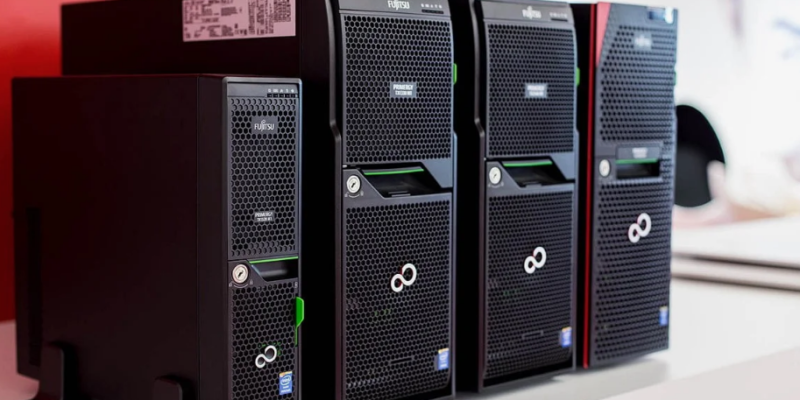
Proper maintenance of the tower server is crucial for maintaining its sustainable performance and reliability. Maintenance includes cleaning and dusting, hardware updates, routine inspections, and maintaining security and performance. All these help enhance overall productivity, allowing you to work easily.
In addition, the maintained tower server helps to enhance the data centralization process, which allows you and your team to access it anytime from any device. This makes teamwork easy and fast, allowing smooth collaboration.
Now, let us know what the maintenance requirements are for tower servers.
Regular Cleaning and Dusting
One of the main requirements for maintaining tower server is regular cleaning and dusting. Dust can significantly affect your server’s efficiency, leading to problems like reduced airflow and overheating.
Further, if you want to enhance the server’s working, use Intelligent Thermal Management. This technique works in tandem with the cleaning routine to manage heat more effectively. Another element you can use is a dust resistance filter. This can enhance the cleaning by removing the particles of dust from the server, allowing you to work seamlessly.
Backup Data for Easy Access
Backing up the data is one of the maintenance tasks of the tower server. This means when you backup your entire data, it helps you to get access easily with no further searching. This can also help you when your data is lost or stolen.
According to Garter, companies with robust backup strategies can reduce downtime by up to 70%.
Further, a reliable backup system addresses lost data issues by creating copies of your data that can be restored when needed. Regular backups ensure that you have recent copies of your files, databases, and system configurations, making it easier to recover quickly from unexpected problems. This practice not only protects against data loss but also minimizes downtime and supports business continuity.
Monitor Temperature for Smooth Performance
Monitoring your server’s temperature is vital for maintaining smooth performance and preventing hardware issues. If you are using the tower server without temperature maintenance, then you can face issues like slowdowns, unexpected shutdowns, or hardware damage due to overheating. This can cause a slowdown to your operating system and prevent you from managing your tasks.
But, by monitoring temperature, can help you keep track of your server’s internal temperatures. Further, look for a server that has built-in sensors that provide real-time data on various components like CPUs, GPUs, and hard drives. With this, you can identify any components that are running too hot and take corrective action before they cause problems.
Update Operating System and Software
The other maintenance point you should look into on the tower server is updating the operating system and software. Before you start updating, you may have faced issues like security vulnerabilities, software incompatibilities, or performance problems due to outdated versions. These issues can lead to system instability, increased risk of cyberattacks, and diminished efficiency.
But if you update your operating system, you ensure that you have the latest security patches and performance enhancements. This reduces the risk of exploits that target known vulnerabilities in outdated software. Some servers often include new features, improved functionality, and bug fixes that enhance your server’s performance.
Check Cable Connections
Checking your cable connections is a fundamental but often overlooked aspect of maintaining your server’s performance. To ensure that the server performs well, ensure all the cables are tight but not loose. Loose cables can lead to intermittent signal loss or complete disconnection, impacting network performance and server reliability.
One technology that can assist with this is cable management systems. These systems help organize and secure cables, reducing damage risk and ensuring connections remain stable. Proper cable management also improves airflow within your server rack, improving cooling and overall system efficiency.
If you want your cable to be equipped properly, ensure that you use the Network Cable Tester. This device checks the integrity of your network cables, identifying issues such as broken wires or improper connections. By using a cable tester, you can quickly diagnose and resolve connectivity issues, ensuring that your network operates smoothly.
Power Supply Maintenance
Before establishing a maintenance routine, you may have experienced issues like sudden power failures, system crashes, or hardware damage due to power supply problems. These issues often stem from inadequate maintenance, leading to disruptions in your operations.
Regular power supply maintenance involves several key practices. First, check the power supply unit (PSU) for dust and debris, which can affect its cooling efficiency and potentially lead to overheating. Keeping the PSU clean helps maintain proper airflow and prevents overheating, which can cause system instability or damage.
Security Updates to Secure Data
Knowing the security updates is the most important point for maintaining the tower server. This helps you secure the data saved in your system, allowing you to work wirelessly.
However, if you do not update your server’s security, you can face issues like data breaches, ransomware attacks, or system vulnerabilities due to outdated software. These problems can lead to significant security risks and operational disruptions.
You can also use tools like Qualys or Tenable. This can scan your systems for vulnerabilities and recommend updates and patches. These tools help you stay ahead of potential threats by identifying and addressing weaknesses before they can be exploited.
Conclusion,
If you use a tower server for your organization, maintaining it is crucial for smooth workflow and effectiveness in overall productivity. This means you need to take care of the server with some proper strategies such as cleaning and dusting, software updates, hardware and business application updates, and others.
All this can help you enhance your tasks such as data transfer, statistical management, smooth IT workflow, etc. This helps you enhance your business in the market and make it globally reputable.










